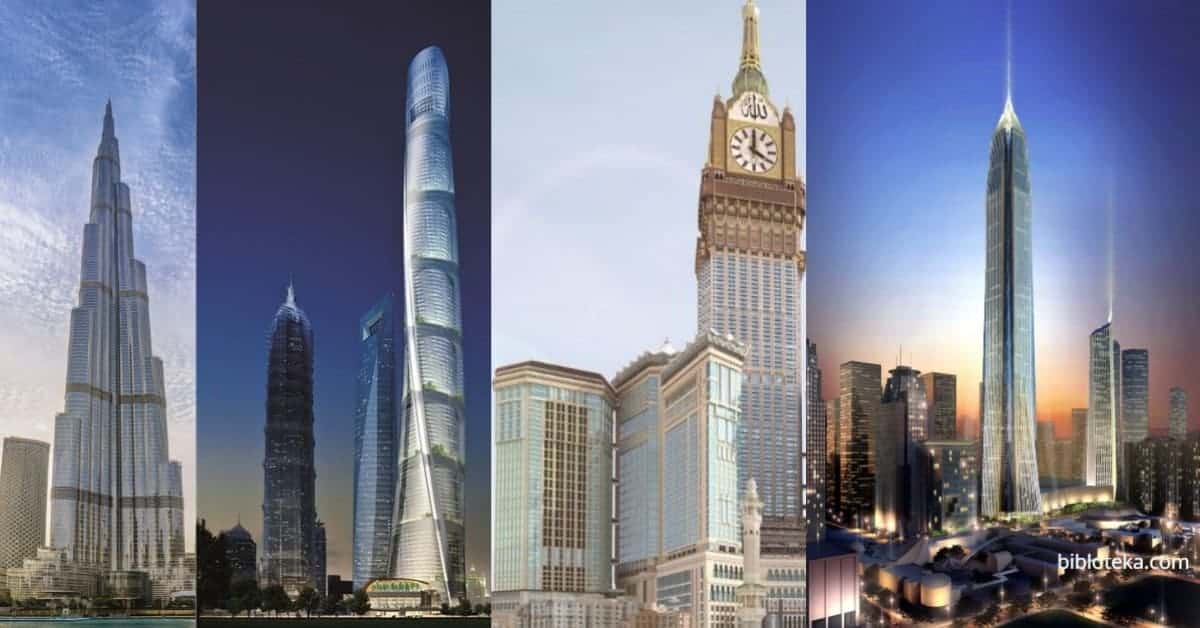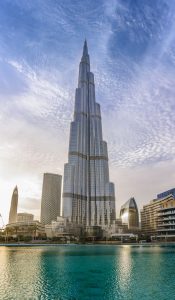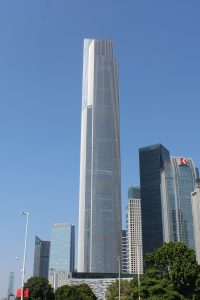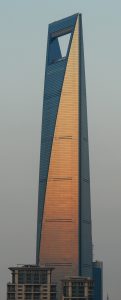The tallest buildings in the world, also called skyscrapers, are one of the greatest works of engineering and architecture that man can do, in fact, each of them can be said to be a new milestone in which man tries to improve himself meter by meter.
In the discussion about which buildings are the tallest, issues such as the difference between a building (habitable) or a tower, or the height of the possible antenna, come up for debate.
What is a Skyscraper?
A skyscraper is simply a high-rise habitable tower. Skyscrapers a large number of floors and stand out, due to their size, from neighboring buildings.
In other words, a Skyscraper is a considerably taller building than the rest of the buildings around it. It is one of the great conquests of modern structural design, made possible by the multi-storey portico and by the high resistance of steel and concrete.
To define these issues, the Council on Tall Buildings and Urban Habitat, known by its acronym CTBUH, was created in 1969, an international non-profit organization that promoted the title of “Tallest Building in the world ”(The World’s Tallest Building) and established the standards by which buildings are measured.
The issue that has always sparked the most controversy has been the consideration of needles and antennas at height. Because having taller buildings in built area or plants, the height of the spiers have marked the final heights and in fact, historically they have been used to surpass some buildings over others in this “crazy” race to achieve being the tallest building.
Finally, the council decided that the needles do count as height and are considered integral parts of the architectural design of buildings, since their changes substantially modify the appearance and design of the building, while antennas can be added or removed without such consequences.
The distinction between building or tower is also relevant. To be considered skyscrapers they must be complete or at least, they must have been architecturally crowned, as in the case of buildings under construction that are part of the list and must have at least 50% of their structure in use (hotel, offices, among others).
History of Skyscrapers
Not everyone knows about the history of skyscrapers and how they appeared. This is a rather interesting story about this in our new article.
Time passed, small companies grew and turned into powerful corporations, and a new generation of industrial and financial magnates demanded more and more impressive premises for their headquarters.
The need for new offices successfully coincided with the development in the nineteenth century of construction techniques for a new type of building – skyscrapers. Until the 1880s, the construction of buildings above the 8th-9th floors was considered irrational, since the buildings made of bricks required such a strength of the base that even opening windows and doors in the lower floors were unsafe, however, as a result of many small and one big innovation, the construction of skyscrapers suddenly became possible.
The main innovation was that the walls of the houses began to be made lighter because the building did not rest on them but on a steel frame.
The word skyscraper (skyscraper) has existed in England since 1794 and was used in many different meanings: a high hat, a high ball in baseball, and the highest sail on a ship. For the first time this word was used to describe a house in 1888 (although the term skyscraper building appeared four years before) and not in New York, as one might think, but in Chicago.
In the last quarter of the nineteenth century, Chicago was the leading city in the world in the construction of large structures for a very simple reason – because of the devastating fire of 1871.
Chicago’s first skyscraper was the House Insurance Company building, built between 1883-1885, quickly followed by Leiter House (1889), House of Confidence (1894) and Carson, Peary, and Scott House (1889). Soon, skyscrapers so changed the cityscape (cityscape, Americanism of 1850) throughout America, that the word skyline, previously meaning “horizon line”, has acquired a modern meaning – the outlines of skyscrapers against the sky
Skyscrapers were born in Chicago, but New York became their real homeland. The first New York skyscraper, the twenty-two-story New York Peace House, opened in 1890, and soon other high-rise buildings rose above the city: Pulitzer (1892, 93 meters), Flatair (Iron) (1903, 86 meters) ), The Times Tower (1904, 110 meters), Singer (1908, 180 meters), Underground Life (1909, 210 meters) and, finally, the Woolworth House (240 meters) built-in 1913.
Top 10 tallest and impressive skyscraper buildings
These are, to this day, the ten tallest skyscraper buildings in the world.
1.THE BURJ KHALIFA. DUBAI (The tallest)
Located in Dubai, it has 828 meters spread over 163 floors.
The construction of this impressive building ( Burj in Arabic means tower ) began on September 21, 2004, and ended on January 4, 2010, more than a year later than planned. The project was awarded through a competition to the Skidmore, Owings and Merrill studio, experts in skyscrapers and the main architect in charge of the project were Adrian Smith. The structure of the building is made of reinforced concrete up to the 156th floor (586 m high) and from the 156th floor, the floors are made of steel, which makes them lighter. Its interior design was commissioned to designer Nada Andric who combined the Using glass, stainless steel, polished stones, stucco walls, artisan textures, and rock floors, drawing inspiration from the local culture of Dubai. Furthermore, more than 1,000 carefully selected works of art adorn the building and its surroundings. The building can be visited and you can access its two viewpoints, one on the 124th floor and the other on the 555th.
2.SHANGHAI TOWER, CHINA
In Shanghai at 632 meters high with 128 floors in the building, the Shanghai Tower occupies the second position and is the tallest building in China. Designed by Gensler, it is a building that stands out for its sustainability. The building is lined with a second glass “skin” that acts as a thermos, which allows it to be isolated and saves energy. It is also capable of reducing wind loads in the building by 24%, its characteristic spiral design collects rainwater used for tower air conditioning and heating systems while wind turbines generate power to supply the building.
3.ABRAJ AL-BAIT CLOCK TOWER, SAUDI ARABIA
Located in Mecca. It has a height of 601 meters and 120 plants. It is the largest building in the world by its mass or volume and the tallest building in Saudi Arabia. Located in the place that Muslims consider the most holy in the world, the building has space for prayer with the capacity to house approximately four thousand people. The tallest tower contains a five-star hotel to accommodate the more than two million pilgrims who participate in Hajj each year. The clock that houses the tower is the largest in the world at 43×43 meters and the highest (400 m).
4.PING AN FINANCE CENTER, CHINA
Located in the Chinese city of Shenzhen, of very recent construction since its construction finished in 2017, it has a height of 599 meters and 115 floors. The tower was commissioned by the insurance company Ping An Insurance and designed by the American architectural firm Kohn Pedersen Fox.
5.LOTTE WORLD TOWER, SOUTH KOREA
This skyscraper in Seoul, the capital of South Korea, is 554.5 meters high and has 123 floors. Also of very recent construction. In fact, it was opened on April 3, 2017, and is the tallest skyscraper in South Korea. It houses one of the highest observation platforms in the world on its 123rd floor at 512.3 meters from the ground.
6.ONE WORLD TRADE CENTER, U.S
In New York, it has a height of 541.3 meters and 104 plants. The One World Trade Center is, without a doubt, a building with special meaning because it was built after the 2001 terrorist attacks in New York. Originally it was called Freedom Tower but later it has been renamed as the North Tower of the original World Trade Center, which disappeared in the attacks. The skyscraper is located in Lower Manhattan, a few meters from the destroyed twin towers, and is the tallest skyscraper in the Western Hemisphere. The architect of the project was David Childs, who again is an architect for the Skidmore, Owings & Merrill (SOM) studio (Burj Khalifa and Willis Tower).
His works ended in 2014 and one of the most relevant discussions in its design and, which partially slowed down the project, were security measures. The building has 91 cm thick reinforced concrete walls, three extremely wide stair lines, a line of stairs exclusively for use by firefighters, elevators, irrigation systems, and chemical and biological filters in ventilation ducts. In its final design, even the safety issues raised by the New York Police Department were taken into account, including a 57-meter concrete base made of explosion-resistant stainless steel and glass panels.
7.Guangzhou CTF FINANCE CENTER, CHINA
In Tianjin, China with a height of 530 meters and 111 floors, its slightly curved glass skin “hides” a structure prepared for high seismic activity.
8.TIANJIN CHOW TAI FOOK BINHAI CENTER, CHINA
Again in Tianjin, this building is still under construction although nearing completion. Like the previous one, this building will also be 530 meters high with 96 typical floors, so that together with CTF Finance it will dominate the Tianjin skyline.
9.CITIC Tower, Beijing
The CITIC Tower will be the flagship building of Beijing’s comprehensively planned 30-hectare core central business district. this building is 527.7 meters high.
The gently rising and curving shape of the tower resembles an ancient Chinese ceremonial vessel, called the “zun.” The design idea is that of a rotating shell that slowly bends to create a dramatic shape. The definition is also applicable to other main elements of the tower, including the exits, the ground floor lobby, and the observation deck. At the base, the tower is pressed into the ground with huge corner supports, while the outer shell is gently raised and extended out on the four sides. The architecture physically extends the lobby outwards, creating complex drop-off areas.
10.TAIPEI 101, TAIWAN
In Taipei, Taiwan, 508 meters high and 101 plants. Built between 1999 and 2004, Taipei 101 is an icon in Taiwan and a symbol between technological evolution and Asian tradition. According to its technicians, the building can withstand earthquakes of up to 7 degrees on the Richter scale and winds of more than 450 km / h. A curious fact about the building is that it houses the world’s fastest elevator, capable in 37 seconds, of moving 30 people from the fifth floor to 101.
11.SHANGHAI WORLD FINANCIAL CENTER, CHINA
Shanghai boasts this impressive 492-meter, the 101-story building that has received multiple awards for its design. The most characteristic feature is its opening in the upper area, which in addition to attending to aesthetic reasons, is a solution to reduce the pressure of the wind on the building.
Conclusion
This case is now coming to an end. As you can see, the rise of skyscrapers has never stopped since the end of the 19th century. New manufacturing techniques, combined with new materials, have always allowed architects to imagine buildings that are more and more ambitious, and the will of man gives the means to achieve them.
See Also
Most in Demand Engineering Jobs




















